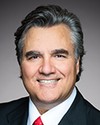Thank you for the question. In this case, we held a competition, which is subject to international trade laws, as you know. In terms of the $900 million or so announced at the end of last December, the President of Siemens made a commitment to invest money in Canadian content or to find 20% Canadian content. Under the circumstances, Siemens has created a website through which it invited Canadian suppliers to express their interest in participating in what the company calls a supply day. The purpose was to allow suppliers in Quebec and Ontario to interact with the company. The movement has already started. We are of course letting the folks from Siemens do that work, but we have already started to move forward with them on implementing the initiative.
In addition, I would like to add that VIA Rail is renewing its fleet quite extensively, apart from what Siemens is doing. We have invested more than $154 million in modernizing our Heritage fleet and making it more accessible. The four suppliers who were selected and received the funding come from Quebec.



